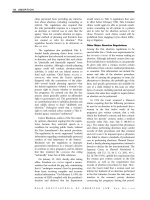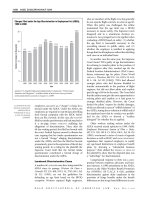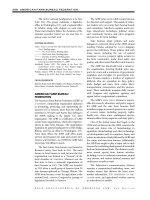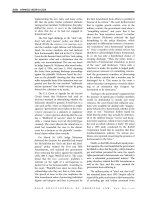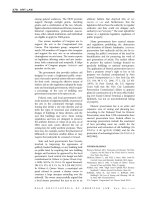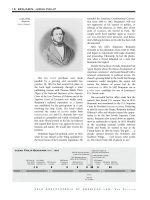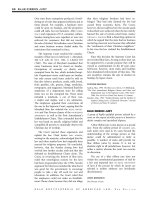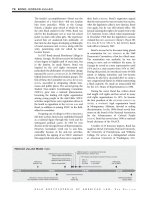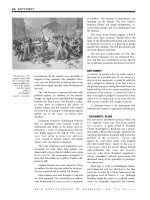Gale Encyclopedia Of American Law 3Rd Edition Volume 5 P4 pptx
Bạn đang xem bản rút gọn của tài liệu. Xem và tải ngay bản đầy đủ của tài liệu tại đây (420.51 KB, 10 trang )
by the National Conference of Commissioners
on Uniform State Laws in 1968. By 1984 every
state had adopted a version of the UCCJA. In
1980, Congress passed the Parental
KIDNAPPING
Prevention Act (28 U.S.C.A. § 1738A), which
aids enforcement and promot es finality in
child custody decisions by providing that
valid custody decrees are entitled to full faith
and credit enforcement in other states. The
VIOLENCE AGAINST WOMEN ACT OF 1994 (Pub. L.
No. 103-322 [codified in scattered sections of 8
U.S.C.A., 18 U.S.C.A., 42 U.S.C.A.]) extends full
faith and credit to the enforcement of protective
orders, which previously were not enforced
except in the state where they were rendered.
This gave a new measure of protection to
victims who moved to a different state after
obtaining a protective order in one state.
FURTHER READINGS
Cooke, Edward F. 2002. A Detailed Analysis of the
Constitution. Lanham, MD: Rowman & Littlefield.
Demelis, Linda M. 1994. “Interstate Child Custody and
the Parental Kidnapping Prevention Act: The Continu-
ing Search for a National Standard.” Hastings Law
Journal 45.
Hamilton, Heather. 1998. “The Defense of Marriage Act:
A Critical Analysis of Its Constitutionality under the
Full Faith and Credit Clause.” DePaul Law Review 47
(summer).
Hasegawa, Kaleen S. 1999. “Re-Evaluating the Limits of the
Full Faith and Credit Clause after Baker v. General
Motors Corporation.” Univ. of Hawaii Law Review 21
(winter).
Olson, Thomas A. 1995. “Rethinking Montana’s View of
Interstate Custody Disputes.” Montana Lawyer 20.
Shuki-Kunze, Jeennie R. 1998. “The ‘Defenseless’ Marriage
Act: The Constitutionality of the Defense of Marriage
Act as an Extension of Congressional Power under the
Full Faith and Credit Clause.” Case Western Reserve Law
Review 48 (winter).
v
FULLER, MELVILLE WESTON
Melville Weston Fuller served as chief justice
of the U.S. Supreme Court from 1888 to 1910.
Fuller’s term as chief justice was marked
by many decisions that protected big business
from
FEDERAL laws that sought to regulate
interstate
COMMERCE. In addition, the Fuller
Court’s restrictive reading of the
FOURTEENTH
AMENDMENT
led it to render the infamous
SEPARATE BUT EQUAL racial segregation decision
in PLESSY V. FERGUSON, 163 U.S. 537, 16 S. Ct.
1138, 41 L. Ed. 256 (1896).
Fuller was born February 11, 1833, in
Augusta, Maine. He grew up in the household
of his maternal grandfather, the chief justice of
the Maine Supreme Judicial Court. Following
his graduation from Bowdoin College in 1853,
he apprenticed in his uncles’ law offices and
briefly attended Harvard Law School. Even
though he did not receive a law degree, he
was the first chief justice of the U.S. Supreme
Court to serve with significant academic legal
preparation. Fuller moved to Chicago in 1856
and established a law practice. An active
member of the
DEMOCRATIC PARTY, he served in
the Illinois
CONSTITUTIONAL Convention of 1861
and for one term (1862–64) in the state house
of representatives. He attended as a
DELEGATE
every national Demo cratic convention between
1864 and 1880.
Fuller withdrew from day-to-day politics
after he married Mary Ellen Coolbaugh, the
daughter of a prominent Chicago banker, in
1866. His law practice thrived because of this
family connection, and with his new wealth, he
invested in real estate. Fuller specialized in
APPELLATE practice, appearing before the U.S.
Supreme Court many times.
Fuller’s appointment to the Court in 1888
was driven by presidential politics and his long
service to the Democratic Party. President
Grover Cleveland, a Democrat who believed
that it would be essential to win the state of
Illinois as part of his re-election bid, nominated
Fuller as chief justice to replace
MORRISON R.
WAITE, who had died in March 1888. Ful ler and
Cleveland were friends and political colleagues.
At the time, the press described Fuller as “the
most obscure man ever appointed Chief Justice”
(Baker 1991, 360). Others were more unkind,
dubbing him “the fifth best lawyer from the
City of Chicago” (review of The Chief Justiceship
of
MELVILLE W. FULLER 1996, 109).
Fuller’s 22-year term as chief justice was
distinguished by his skillful handli ng of often
contentious Court conferences. Justice
OLIVER
WENDELL HOLMES
, JR. thought highly of Fuller’s
ability to maintain collegiality. At the end of his
own legal career, Holmes ranked Fuller as the
best chief justice under whom he had served.
Fuller was an energetic
JURIST who also served on
the Permanent Court of
ARBITRATION, at The
Hague, Netherlands. That international organi-
zation, comprising jurists from various coun-
tries, ruled on world disputes. In 1899 Fuller
arbitrated a boundary dispute between Vene-
zuela and British Guyana.
GALE ENCYCLOPEDIA OF AMERICAN LAW, 3RD E DITION
18 FULLER, MELVILLE WESTON
The U.S. economy grew rapidly while Fuller
served as chief justice. This expansion led to the
concentration of economic power in certain
industries by a small number of individuals and
corporations. The federal government’s efforts
to regulate interstate commerce and to curtail
the power of monopolies and trusts met fierce
opposition from both the affected businesses
and those who believed in a restricted role
for the national government. Opponents of
national power argued for continued adherence
to the doctrine of
FEDERALISM. That doctrine has
many facets, including a fundamental
ASSUMP-
TION
that the national government must not
intrude on the power of the states to manage
their affairs.
Fuller believed in federalism, and he dem-
onstrated this belief in his votes with the
conservative majority on the Court. Writing
for the majority in United States v. E. C. Knight
CO., 156 U.S. 1, 15 S. Ct. 249, 39 L. Ed. 325
(1895), Fuller took the teeth out of the
SHERMAN
ANTI
-TRUST ACT of July 2, 1890, which had
declared illegal “every contract, combination in
the form of a trust, or
CONSPIRACY in RESTRAINT OF
TRADE
and commerce among the several states”
(26 Stat. 209, c. 647). finding in favor of the
Sugar Trust, a corporation that controlled
virtually all sugar refining, Fuller held that a
monopoly of manufacturing was not a monop-
oly of trade or commerce prohibited by the
Sherman Act, as the manufacture of a product
for sale is not commerce. It was up to each state,
not the federal government, to protect its
citizens from monopolistic business practices.
The mere fact that goods were transported in
interstate commerce was not sufficient to give
Congress, under the
COMMERCE CLAUSE, the
authority to regulate business. The holding in
Knight survived until the
NEW DEAL era of the
1930s, when power shifted to the federal
government.
Fuller’s belief in a limited role for the federal
government was also demonstrated in Pollock v.
Farmers’ Loan & Trust Co., 157 U.S. 429, 15 S.
Ct. 673, 39 L. Ed. 759 (1895). In Pollock, Fuller
ruled invalid a federal law that imposed a two-
percent tax on incomes of more than $4,000.
Article I of the Constitution requires that
“direct taxes shall be apportioned among the
Melville W. Fuller.
LIBRARY OF CONGRESS
▼▼
▼▼
Melville Weston Fuller 1833–1910
18251825
18751875
19001900
19251925
18501850
❖
1833 Born,
Augusta, Me.
1910 Died,
Sorrento, Me.
1914–18
World War I
◆
1856 Moved to
Chicago and set
up a law practice
1861–65
U.S. Civil War
1862–64 Served
in the Illinois
House of
Representatives
❖
1888–1910 Served as
chief justice of the U.S.
Supreme Court,
appointed by President
Cleveland
◆
◆
◆
1895 Wrote majority opinions for United States v. E.C.
Knight Co. and Pollock v. Farmers' Loan & Trust Co.
1899 Helped arbitrate the settlement of the boundary
dispute between Venezuela and British Guiana
1896 Voted with the majority in Plessy v. Ferguson to
uphold racial segregation in public transportation
GALE ENCYCLOPEDIA OF AMERICAN LAW, 3RD E DITION
FULLER, MELVILLE WESTON 19
several states according to their respective
numbers.” In a 5–4 vote, Fuller’s Court held
that the new
INCOME TAX was a DIRECT TAX insofar
as it was based on incomes derived from land
and, as such, it had to be apportioned among
the states. As the law did not provide for
APPORTIONMENT, it was unconstitutional.
Decisions such as Knight and Pollock led
critics to call Fuller and the conservative
members of the Court the puppets of business
interests and the protectors of wealth. In
response to Pollock, the
SIXTEENTH AMENDMENT
was ratified by the states in 1913, authorizing
the collection of a federal income tax.
Fuller’s most dubious distinction is that he
voted with the majority in Plessy to uphold
racial segregation in public transportation. At
issue in Plessy was an 1890 Louisian a law that
required passenger trains that operated within
the state to provide “separate but equal”
accommodations for the “white and colored
races.” By a 7–1 vote, with one judge abstaining,
the Court rejected the idea that the Fourteenth
Amendment, enacted after the Civil War to
preserve the
CIVIL RIGHTS of newly freed slaves,
“could have been intended to abolish distinc-
tions based upon
COLOR, or to enforce social, as
distinguished from political, equality, or a
COMMINGLING of the two races upon terms
unsatisfactory to either.”
With its focus on a limited national
government and support of legally enforced
racial segregation, the 22-year period of the
Fuller Court has, in the words of legal histori an
Richard A. Epstein, “often been regarded as a
black hole of American Const itutional law.”
With the conservative political and legal renais-
sance of the 1980s and 1990s, however, Fuller
came back into favor, being regarded by some
legal scholars as a jurist who was committed to
economic development, market institutions,
and limited government.
Fuller died July 4, 1910, in Sorrento, Maine.
FURTHER READINGS
Baker, Liva. 1991. The Justice from Beacon Hill: The Life
and Times of Oliver Wendell Holmes. New York:
HarperCollins.
Ely, James W., Jr. 1995. The Chief Justiceship of Melville W.
Fuller, 1888–1910. Columbia, SC: Univ. of South
Carolina Press.
Furer, Howard B., ed. 1986. The Fuller Court, 1888–1910.
New York: Associated Faculty Press.
FUND
A comprehensive term for any money that is set
aside for a particular purpose or that is accessible
for the satisfaction of debts or claims.
The term public funds is a colloquial label
for the revenue of a government, state, or
MUNICIPAL CORPORATION.
FUNDAMENTAL LAW
The constitution of a state or nation; the basic law
and principles contained in federal and state
constitutions that direct and regulate the manner
in whi ch government is exercised.
FUNDAMENTAL RIGHT
A fundamental right is a core individual constitu-
tional right that is given the highest degree of
judicial deference.
The Supreme Court has identified cert ain
individual rights as fundamental
CONSTITUTIONAL
rights that must be protected from government
restrictions. To accomplish this objective, the
Court has established the
STRICT SCRUTINY test,
which is the most rigorous standard of
JUDICIAL
REVIEW
. The Court will apply the scrutiny test
only when a
FUNDAMENTAL RIGHT or a SUSPECT
CLASSIFICATION
such as race is involved. The
government must have a compelling interest to
restrict a fundamental right. Even if the
government has such an interest, it must show
that the law or policy is the least restrictive
means of achieving this goal.
The fountainhead of fundamental rights is
the Constitution’s
BILL OF RIGHTS. The FIRST
AMENDMENT
identifies the right to FREEDOM OF
SPEECH
, the right to religious freedom, and
the right to freedom of association as funda-
mental rights. The
SECOND AMENDMENT protects
the right to keep and bear arms, which is viewed
as a core right. The
FIFTH AMENDMENT protects
the right to
DUE PROCESS OF LAW and the right
against
SELF-INCRIMINATION. Over time the
Supreme Court has acknowledged other funda-
mental rights that are not explicitly stated in the
Constitution. These include the right to travel
within the United States, the right to private
property, the right to vote, the right to privacy,
the right to procreation, and the right to marry.
The recognition of certain fundamental
rights applied only to actions taken by the
FEDERAL
government until the enactment of the FOUR-
TEENTH AMENDMENT
following the Civil War. This
IF THE PROVISIONS OF
THE
CONSTITUTION
CAN BE SET ASIDE
BY AN ACT OF
CONGRESS, WHERE
IS THE COURSE
OF USURPATION
TO END
?
—MELVILLE WESTON
FULLER
GALE ENCYCLOPEDIA OF AMERICAN LAW, 3RD E DITION
20 FUND
amendment guaranteed individuals that state
governments could not deny the m due process of
law,
EQUAL PROTECTION of law, or all recognized
PRIVILEGES AND IMMUNITIES of law. The Supreme
Court, concerned that the amendment gave too
much power to the federal courts, refused to read
these three clauses broadly until the late 1930s.
The Court slowly began to apply fundamental
rights from the Constitution to the states,
selectively incorporating them into the Four-
teenth Amendment’s due process clause.
Fundamental rights that are not specifically
stated in the Constitution have been based on
due process clauses of the Fifth and Fourteenth
Amendments. The doctrine of
SUBSTANTIVE DUE
PROCESS
bars the government from infringing on
fundamental constitutional right. Unlike proce-
dural process, where the administration of the
law is examined, substantive due process deals
with liberties that are not expressly listed in the
Bill of Rights but which are found to be essential
concepts of freedom and equality.
Using substantive due process, the Supreme
Court has recognized the right to personal
autonomy, bodily integrity, self-dignity, sexual
identity, and
SELF-DETERMINATION under the
umbrella of an individual’s right to privacy. In
the 1960s, the Court used the right to privacy in
Griswold v. Connecticut (381 U.S., 85 S. Ct.
1678, 14 L. Ed. 2d 510 [1965]) to strike down a
law forbidding married adults from using
BIRTH
CONTROL
. The right to privacy was extended in
Eisenstadt v. Baird (405 U.S. 438, 92 S. Ct. 1029,
21 L. Ed. 2d 349 [1972]). The Court struck
down a state law that prohibited unmarried
persons from obtaining contraceptives. This
decision paved the way fo r one of the most
controversial decision in U.S.
LEGAL HISTORY,
which was based on substa ntive due process:
Roe v. Wade (401 U.S. 113, 93 S. Ct. 705, 35 L.
Ed. 2d 147 [1973]). The Court ruled that the due
process clause gave women the right to have an
ABORTION during the first trimester of pregnancy
without state
INTERFERENCE.
Critics of substantive due process point to
the Roe decision as an example of the perils of
using the doctrine. They contend that substan-
tive due process gives judges the ability to inject
their own values and prejudices into a contro-
versial issue. Moreover, the use of this doctrine
to identify fundamental rights discredits the
judicial decision-making process and leads
many to believe the decis ion was illegitimate.
In addition, critics note that later generations of
justices have overturned substantive due process
rulings, concluding that the right identified,
such as liberty of contract, is not fundamental.
Despite these criticisms, the Court used
substantive due process in 2003 to overturn a
RULING on homosexuality. In Lawrence v. Texas
(539 U.S. 558, 123 S. Ct. 2472, 156 L. Ed. 2d
508), the Court overturned a state law that
made
SODOMY between homosexuals a crime.
Justice ANTHONY KENNEDY, writing for the major-
ity, invoked Roe and the birth control decisions,
stating that these cases made clear that the due
process clause “has a subst antive dimension of
fundamental significance in defining the rights
of the person.” As a general rule, the state
should not attempt to “define the meaning of
the relationship or to set its
BOUNDARIES absent
INJURY to a person or abuse of an INSTITUTION the
law protects.” If homosexuals wish to express
their sexuality in certain conduct the Constitu-
tion allows them “the right to make the choice.”
The Court’s decision to declare a due process
right to consensual, intimate conduct again
angered social conservatives, who claimed that
the Court was applying its own pro-homosexual
views rather than following the commands of
the Constitution.
The identification of fundamental right s is
important. Once given this status and the strict
scrutiny review standard that makes it difficult
for the government to impose restrictions, the
right becomes one more piece in the foundation
of U.S.
CONSTITUTIONAL LAW.
FURTHER READINGS
Flack, Horace Edgar. 2003. The Adoption of the Fourteenth
Amendment. Birmingham, Ala.: Palladium Press.
Langran, Robert. 2003. The Supreme Court: A Concise
History. New York: Peter Lang.
Tribe, Lawrence. 2008. The Invisible Constitution. New York:
Oxford Univ. Press.
CROSS REFERENCES
Rational Basis Test; Strict Scrutiny; Suspect Classification.
FUNGIBLE
A description applied to items of which each unit
is identical to every other unit, such as in the case
of grain, oil, or flour.
FUNGIBLE goods are those that can readily be
estimated and replaced according to weight,
measure, and amount.
GALE ENCYCLOPEDIA OF AMERICAN LAW, 3RD E DITION
FUNGIBLE 21
FURMAN V. GEORGIA
In Furman v. Georgia, 408 U.S. 238, 92 S. Ct.
2726, 33 L. Ed. 2d 346 (1972), the U.S. Supreme
Court struck down three death sentences,
finding that they constituted
CRUEL AND UNUSUAL
PUNISHMENT
in violation of the Eighth and
Fourteenth Amendments to the U.S . Constitu-
tion. Hailed, at the time, as a victory for
opponents of the death penalty, Furman actually
helped states rewrite their death penalty laws to
pass
CONSTITUTIONAL muster.
The path to Furman began in 1962 with
ROBINSON V. CALIFORNIA, 370 U.S. 660, 82 S. Ct.
1417, 8 L. Ed. 2d 758. In Robinson, the U.S.
Supreme Court ruled that the Cruel and Unusual
Punishments Clause could be applied to the
states through the
FOURTEENTH AMENDMENT.
Opponents of the death penalty saw this
RULING
as an opportunity to litigate the constitutionality
of state death penalty cases in FEDERAL court.
Furman centered on the convictions and
death sentences of three African American men:
William Henry Furman was convicted in Georgia
for murder, Lucious Jackson was convicted in
Georgia for
RAPE, and Elmer Branch was convicted
in Texas for rape. The juries in each of the cases
were not mandated by law to vote for the death
penalty, nor were they given specific criteria to
evaluate in making their penalty decisions.
The U.S. Supreme Court issued a
PER CURIAM
opinion, on a 5–4 vote to reverse the death
sentences. The Court typically issues its deci-
sions with a majority opinion written and
signed by one the justices. On rare occasions
the Court will issue a per curiam decision,
which takes the form of a
BRIEF, unsigned
opinion. A per curiam decision signifies that the
Court was deeply divided over the reasons that
went into its ultimate decision to either affirm
or reverse the lower court.
All nine justices wrote a separate opinion to
articulate their reasoning. Although five justices
voted to reverse the death sentences, their
concurring opinions revealed that it was a shaky
coalition. Justices
WILLIAM O. DOUGLAS, William J.
Brennan Jr., and
THURGOOD MARSHALL doubted
that any application of the death penalty could
avoid being a cruel and unusual punishment.
Justice Douglas concluded that the death
penalty was disproportionately applied t o people
who were poor and socially disadvantaged. This
disproportion suggested that the
EQUAL PROTECTION
Clause of the Fourteenth Amendment must be
applied to s trike down the death penalt y because
any inequalit y of application was cruel and unusual
punishment. Douglas’s opinion raised the possibil-
ity that proportionate application would make
CAPITAL PUNISHMENT constitutional.
Justices Brennan and Marshall sta ked out an
absolutist position, finding the death penalty per se
cruel and unusual punishment, given the “evolving
standards o f decency” they saw in contemporary
U.S. society. This meant t hat no matter t he
FACT
SITUATION
, no matter the proper application of due
process and equal protection, capital punishment
was inherently unconstitutional.
The most influential opinion came from
Justice
POTTER STEWART:
The penalty of death differs from all other
forms of criminal punishment, not in degree
Elmer Branch, one
of the plaintiffs in
Furman v. Georgia,
holds out a newspaper
to another death row
inmate after the
Supreme Court held
that the death penalty
constituted cruel and
unusual punishment.
AP IMAGES
GALE ENCYCLOPEDIA OF AMERICAN LAW, 3
RD E DITION
22 FURMAN V. GEORGIA
but IN KIND. It is unique in its rejection of
rehabilitation of the
CONVICT as a basic
purpose of criminal justice. And it is unique,
finally, in its
ABSOLUTE renunciation of all that
is embodied in our concept of humanity.
Stewart held that because death was different
from any other punishment, it had to be
administered rationally and fairly. He rejected
the absolutist position of Brennan and Marshall,
yet still voted to reverse the penalties of Furman,
Jackson, and Branch because he believed their
death sentences were imposed capriciously.
Stewart looked at the circumstances sur-
rounding the imposition of the three death
sentences. The juries in these cases had been
given unbridled discretion to do what they
wished in deciding whether to impose capital
punishment. The result, in Stewart’s view, was
that the death penalty was “wantonly and
freakishly imposed.” These death sentences
were “cruel and unusual in the same way that
being struck by lightning is cruel and unusual.”
Justice
BYRON R. WHITE took a slightly
different tack, concluding that the infrequency
of execution prevented the penalty from serving
as an effective deterrent and from consisten tly
meeting legitimate social needs for retribution.
Chief Justice
WARREN E. BURGER dissented, as
did Justices
HARRY A. BLACKMUN, Lewis F. Powell
Jr., and
WILLIAM H. REHNQUIST. The dissenters
argued that the Court was straying into an area
properly delegated to the judgment of state
legislatures. The private opinions of justices
about the morality of capital punishment, they
opined, should not be presented as public policy
in a court of law.
The Furman decision stopped all executions
then pending in the 39 states that authorized the
death penalty. More than six hundred persons
were awaiting execution at the time. Faced with
a splintered Supreme Court decision, states had
three options: develop mandatory death sen-
tences for crimes that were carefully defined by
STATUTE, develop jury guidelines to reduce juror
discretion, or abolish capital punishment.
The state of Georgia chose to develop
guidelines for jurors. Once a person is convicted
in a capital trial, the jury must determine, in the
penalty phase, whether any unique aggravating
and
MITIGATING CIRCUMSTANCES should be con-
sidered before the court decides whether to
impose a death sentence. In 1976, the U.S.
Supreme Court upheld these jury guidelines in
GREGG V. GEORGIA, 428 U.S. 153, 96 S. Ct. 2909,
49 L. Ed. 2d 859. With the Gregg decision, the
four-year moratorium on the death penalty
ended and, according to some, launched the
modern era of capital punishment.
FURTHER READINGS
Baldus, David C., et al. 1998. “Racial Discrimination and the
Death Penalty in the Post-Furman Era: An Empirical
and Legal Overview, with Recent Findings from
Philadelphia.” Cornell Law Review 83 (September).
Banner, Stuart. 2003. The Death Penalty: An American
History. Cambridge, MA: Harvard Univ. Press.
Sarat, Austin. 1998. “Recapturing the Spirit of Furman: The
American Bar Association and the New Abolitionist
Politics.” Law and Contemporary Problems 61 (au-
tumn). Available online at />shell/cite.pl?61+Law+&+Contemp.+Probs.+5+(Au-
tumn+1998); website home page: e.
edu (accessed July 25, 2009).
CROSS REFERENCE
Incorporat ion Doctrine.
FUTURE ACQUIRED PROPERTY
Property that is received or obtained by a borrower
subsequent to the date that he or she executes a
loan agreement which offers property currently
owned as collateral.
FUTURE ACQUIRED PROPERTY, which is also
known as after-acquired property, encompasses
both personal property and real property and
provides additional
COLLATERAL to ensure that a
loan will be satisfied. There must, however, be a
provision in the loan agreement between the
borrower and the lender that gives the lender a
right to the specific property of the borrower
that he or she acquires subsequ ent to the
execution of the agreement.
SECURED TRANSACTIONS frequently involve the
treatment of personal property as future acquired
property. For example, a debtor who owns a
retail store might accept a future acquired
property provision in a security agreement with
a creditor in order to obtain funds to buy addi-
tional
INVENTORY. The purchase of new inventory
constitutes additional collateral that ensures the
satisfaction of the loan. Language commonly
used to phrase a future acquired property term in
a contract is “any or all obligations covered by
the security agreement are to be secured by all
inventory now or
HEREAFTER acquired by the
debtor.”
Mortgages, particularly those affecting com-
mercial properties, involve the treatment of real
GALE ENCYCLOPEDIA OF AMERICAN LAW, 3RD E DITION
FUTURE ACQUIRED PROPERTY 23
property as future acquired property. The
mortgagee (who is the lender) will include in
the mortgage an
AFTER-ACQUIRED PROPERTY CLAUSE
which provides that the mortgagee will have an
equitable lien, which is a right to have property
used to repay a debt, in all the real property that
the mortgagor (who is the borrower) obtains
after the mortgage is executed. For example,
ABC Co. owns
BLACKACRE and borrows funds
from XYZ Bank. ABC executes a note and
mortgage on Blackacre to XYZ, which XYZ
records. The mortgage also contains an after-
acquired property clause. When ABC subse-
quently purchases
WHITEACRE to serve as its
warehouse, XYZ automatically obtains an equi-
table lien in Whiteacre. Because a mortgage with
an after-acquired property clause cannot be
traced through an examination of the
CHAIN OF
TITLE
of the after-acquired property, anyone who
subsequently buys or has a lien against the
mortgagor’s property has no notice of the
equitable lien of the mortgagee. Such purchasers
or lienors might, therefore, have greater rights to
the property than the mortgagee if they took the
property in
GOOD FAITH and without notice. The
mortgagee must take additional steps to protect
the priority of his or her lien in future acquired
property. It is a common practice for mortgage
lenders to require that the mortgagor execute a
recordable amendment to his or her mortgage
describing in detail the future acquired property
immediately after its acquisition.
The treatment of future acquired property
varies, however, from
JURISDICTION to jurisdiction.
FUTURE EARNINGS
Earnings that, if it had not been for an injury,
could have been made in the future, but which
were lost as result of the injury.
FUTURE INTEREST
A claim on property, real or personal, that will
begin at some point in the future. A future interest
allows the grantor to retain the right to use that
property until the specified transfer date. Future
interest agreements are often used by donors for
tax purposes. For example, a person may grant a
future interest in his or her home to a charity, with
the stipulation that he will retain use of the home
for the remainder of his life, also called a “life
estate”. Although the charity will not receive the
property until the donor’s death, the donor can
claim a tax deduction the same year the future
interest is granted. Also called future estate.
CROSS REFERENCES
Bequest; Will.
FUTURES
Contracts that promise to purchase or sell
standard commodities at a forthcoming date and
at a fixed price.
This type of contract is an extremely speculative
transaction and ordinarily involves such standard
goods as rice or soybeans. Profit and loss are
based upon promises to deliver—as opposed to
possession of—the actual commodities.
GALE ENCYCLOPEDIA OF AMERICAN LAW, 3RD E DITION
24 FUTURE EARNINGS
GAG ORDER
A court order to gag or bind an unruly defendant
or remove her or him from the courtroom in order
to prevent further interruptions in a trial. In a
trial with a great deal of notoriety, a court order
directed to attorneys and witnesses not to discuss
the case with the media— such order being felt
necessary to assure the defendant of a fair trial. A
court order, directed to the media, not to report
certain aspects of a crime or criminal investigation
prior to trial.
Unruly defendants who disrupt trials are
very rarely literally gagged in modern courts.
However, the U.S. Supreme Court has upheld
the constitutionality of the
PRACTICE in cases
where a
DEFENDANT is particularly disruptive. In
Illinois v. Allen, 397 U.S. 337, 90 S. Ct. 1057, 25
L. Ed. 2d 353 (1970), the Court affirmed that
gagging or binding the defendant, or removing
him or her from the courtroom, does not
violate the Confrontation Clause of the
SIXTH
AMENDMENT
to the U.S. Constitution, which
holds, “In all criminal prosecutions, the
ACCUSED
shall enjoy the right to be confronted with
the witnesses against him.” According to
ASSOCIATE JUSTICE Hugo L. Black, who wrote the
Court’s opinion,
[A] defendant can lose his right to be present
at trial if, after he has been warned by the
judge that he will be removed if he continues
his disruptive behavior, he nevertheless
insists on conducting himself in a manner
so disorderly, disruptive, and disrespectful of
the court that his trial cannot be carried on
with him in the courtroom. Once lost, the
right to be present can, of course, be
reclaimed as soon as the defendant is willing
to conduct himself consistently with the
decorum and respect
INHERENT in the concept
of courts and judicial proceedings.
Of the three methods that the Court found
available to a judge when faced with a disruptive
defendant—gag and shackles,
CITATION for
CONTEMPT of court, and physical removal—the
Court held that a gag and shackles should be
considered the option of
LAST RESORT. According
to the Court,
Not only is it possible that the sight of
shackles and gags might have a significant
effect on the jury’s feelings about the
defendant, but the use of this technique is
itself something of an affront to the very
dignity and decorum of judicial proceedings
that the judge is seeking to uphold.
One of the few modern instances of literal
gagging occurred in the 1968
CHICAGO EIGHT trial
(sometimes called the Chicago Seven trial because
one defendant was removed). In that trial,
FEDERAL
judge Julius J. Hoffman ordered Black Panthers
leader Bobby Seale bound and gagged after Seale
and Hoffman engaged in vociferous argument
during the trial. Seale still managed to disrupt
the proceedings. He was then removed from the
trial and tried separately.
Courts may attempt to control prejudicial
publicity by restricting the information that trial
G
25
participants can give to the press both before
and during a trial. This remains the type of GAG
ORDER
most frequently used by courts.
Another type of g ag
ORDER was for a while
used by courts to restrict the press from
reporting certain facts regarding a trial. This
gag order became more common after the
Supreme Court’s 1966 decision in Sheppard v.
Maxwell, 384 U .S. 333, 86 S. Ct. 1507, 16 L. Ed.
2d 600, in which it reversed a c riminal
CONVICTION on the grounds that PRETRIAL
PUBLICIT Y
had unfairly prejudiced the jury
against the defen dant and denied him his Sixth
Amendment right to a fair trial. However, in a
1976 decision, Neb raska P ress Ass’n v. Stuart,
427 U.S. 539, 96 S. Ct. 2791, 49 L. Ed. 2d 683,
the Court held that pretrial gag o rders on the
press are unconstitutional. It ruled that such
orders represent an unconstitutional
PRIOR
RESTRAINT
and violate the FIRST AMENDMENT,
which guarantees the
FREEDOM OF THE PRESS.
FURTHER READINGS
“Challenges to Gag Orders End in Mixed Results.” 2000.
News Media & the Law 24 (spring).
Minnefor, Eileen A. 1995. “Looking for Fair Trials in the
Information Age: The Need for More Stringent Gag
Orders against Trial Participants.” Univ. of San
Francisco Law Review 30 (fall).
Weiss, Eric A., and Debra L. Slifkin. 1999. “Enforceability of
Rule 26(c) Confidentiality Rrders and Agreements.”
Federation of Insurance & Corporate Counsel Quarterly
49 (winter).
CROSS REFERENCE
Sheppard, Samuel H.
GAG RULE
A rule, regulation, or law that prohibits debate or
discussion of a particular issue.
Between 1836 and 1844, the U.S. House of
Representatives adopted a series of resolutions
and rules that banned petitions calling for the
ABOLITION of SLAVERY. Known as gag rules, these
measures effectively tabled antislavery petitions
without submitting them to usual House proce-
dures. Public outcry over the gag rules ultimately
aided the antislavery cause, and the fierce House
debate concerning their future anticipated later
conflicts over slavery.
The submission of petitions to Congress has
been a feature of the U.S. political system ever
since its inception. The
FIRST AMENDMENT to the
U.S. Constit ution guarantees “the right of the
people to petition the Government for a
REDRESS of grievances.” First used in England,
petitions have been considered an important
means for the people to communicate grie-
vances to their representatives or other public
officials.
When the first
GAG RULE was instituted in
1836, House protocol required that the first
thirty days of each session of Congress be
devoted to the reading of petitions from
constituents. After those 30 days, petitions were
read in the House every other Monday. Each
petition was read aloud, printed, and assigned
to an appropriate committee, which could
choose to address or ignore it. This traditional
procedure had been interrupted in 1835, when
the House began to receive a large number of
petitions advocating the abolition of slavery.
Many of the petitions were organized by the
American Anti-Slavery Society, which had
formed in 1833.
Southern representatives, many of whom
were slave owners and entertained no thoughts
of abolishing slavery, were outraged by the
antislavery petitions. In December 1835, south-
erners, uniting with northern Democrats, won a
vote to table a petition that called for the abolition
of slavery in the
DISTRICT OF COLUMBIA. Breaking
established precedent, the pro-slavery faction also
won a vote to deny the petition its usual
discussion, printing, and referral to committee.
This procedure for the “gagging” of aboli-
tion petitions was made into a formal resolution
by the House on May 26, 1836: “All petitions,
memorials, resolutions, propositions, or papers,
relating in any way, or to any extent whatsoever,
to the subject of slavery or the abolition of
slavery, shall, without being either printed or
referred, be laid on the table and no further
action whatever shall be had thereon.” The
resolution incited strong opposition from many
northerners, who perceived it as a violation of
their time-honored
CIVIL RIGHTS. JOHN QUINCY
ADAMS
, a former president and now a represen-
tative from Massachusetts, emerged as the
leader of an effort to revoke the new resolution.
JOHN C. CALHOUN (D-S.C.), although a member
of the Senate rather than the House, orchestrat-
ed the battle to preserve it.
The pro-slavery faction succeeded in renew-
ing the gag resolution, which expired at the end
of each session of Congress, in both sessions
of the Twenty-fifth Congress (1837–39). On
January 28, 1840, it succeeded again when it
GALE ENCYCLOPEDIA OF AMERICAN LAW, 3RD E DITION
26 GAG RULE
won a vote to turn the resolution into House
Rule 21 (in later ve rsions, Rules 23 and 25):
No petition, memorial, resolution, or other
paper praying the abolition of slavery in the
District of Columbia, or any State or
Territory, or the slave trade between the
States or
TERRITORIES OF THE UNITED STATES,in
which it now exists, shall be received by this
House, or entertained in any way whatever.
As a formal House rule rather than a
resolution, the gag rule was now a permanent
part of House procedure and did not have to be
renewed by vote each session.
This new gag rule provoked even stronger
opposition. Whereas the previo us gag resolution
tabled antislavery petitions after they were
received, the new gag rule did not allow
petitions to be received. It was also more
extreme than the Senate’s approach, which
was to receive such petitions but answer them
in the negative. As a result of these changes,
northerners who had previously supported the
gag now joined Adams in opposing it. Several
years later, on December 3, 1844, those opposed
to the gag rule finally succeede d in rescinding it.
The term gag rule has also been applied to
presidential regulations banning
ABORTION
counseling by employees of family planning
clinics that received a particular type of
FEDERAL
funding.
FURTHER READINGS
Holmes, Stephen. 1988. “Gag Rules, or the Politics of
Omission.” In John Elster and Rune Slagstad, eds.
Constitutionalism and Democracy. Cambridge: Cam-
bridge Univ. Press
Jenkins, Jeffrey A., and Charles Stewart III. 2003. “The Gag
Rule, Congressional Politics, and the Growth of Anti-
Slavery Popular Politics.” Available online at http://th.
myweb.uga.edu/gagrule.pdf; website home page: http://
th.myweb.uga.edu (accessed September 3, 2009).
Miller, William Lee. 1996. Arguing about Slavery: The Great
Battle in the United States Congress. New York: Knopf.
CROSS REFERENCE
Congress of the United States.
GAME
Wild birds and beasts. The word includes all game
birds and game animals.
The state, in its sovereign power, owns game
for the benefit of the general public. The only
manner in which a private individual can
acquire ownership in game is by possessing it
lawfully such as by hunting and killing it under
a license.
Generally, every individual has the right to
hunt and take game in any public place where his
or her presence is lawful, so long as the person
neither violates statutory regulations nor injures
or infringes upon the rights of others. A hunter
does not acquire an
ABSOLUTE right to a wild animal
by mere pursuit alone, and the individual forfeits
any potential ownership by abandoning the chase
prior to capture. The exclusive right to hunt or
take game on privately owned property vests in
the owner or his or her grantees. This
PROPERTY
RIGHT
of the owner is limited by the right of the
state to regulate and preserve the game for public
use. A suit for trespass may be brought against one
who interferes with another’s right to hunt.
A statute that proscribes the hunting of game
without a license, and that requires the p ayment
of a fee for such license, constitutes a proper
exerciseofthepolicepowerofthestate.
Game laws govern the killing or taking of
birds and beasts. Game wardens ordinarily can
arrest violators, seize illegally taken game, bring
actions for trespass, or
INSTITUTE prosecutions
for violations of the game laws.
An Ohio hunter
displays a trophy buck
taken during deer
hunting season. Game
laws govern the killing
or taking of birds and
beasts.
AP IMAGES
GALE ENCYCLOPEDIA OF AMERICAN LAW, 3
RD E DITION
GAME 27
